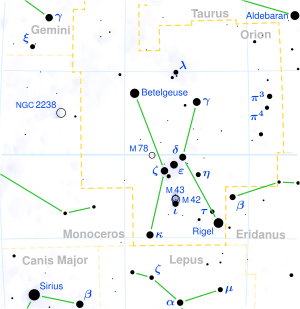Pi4 Orionis

| |
| Observation data Epoch J2000.0 Equinox J2000.0 (ICRS) | |
|---|---|
| Constellation | Orion |
| Right ascension | 04h 51m 12.36472s[1] |
| Declination | +05° 36′ 18.3723″[1] |
| Apparent magnitude (V) | 3.685[2] |
| Characteristics | |
| Spectral type | B2 III[3] |
| U−B color index | −0.797[2] |
| B−V color index | −0.180[2] |
| Astrometry | |
| Radial velocity (Rv) | 23.3[4] km/s |
| Proper motion (μ) | RA: −2.21[1] mas/yr Dec.: +0.85[1] mas/yr |
| Parallax (π) | 3.10 ± 0.18[1] mas |
| Distance | 1,050 ± 60 ly (320 ± 20 pc) |
| Orbit[5] | |
| Period (P) | 9.5191 d |
| Eccentricity (e) | 0.03 |
| Periastron epoch (T) | 2418275.65±10.0 |
| Argument of periastron (ω) (secondary) | 165° |
| Semi-amplitude (K1) (primary) | 25.8 km/s |
| Details | |
| π4 Ori A | |
| Mass | 10.95±0.97[6] M☉ |
| Radius | 9.1[7] R☉ |
| Luminosity | 19,726[6] L☉ |
| Surface gravity (log g) | 3.59[8] cgs |
| Temperature | 21,874±126[7] K |
| Metallicity [Fe/H] | −0.31[8] dex |
| Rotational velocity (v sin i) | 38[9] km/s |
| Age | 15.4±1.0[10] Myr |
| Other designations | |
Pi4 Orionis (π4 Ori, π4 Orionis) is a binary star system in eastern part of the Orion constellation. It is visible to the naked eye with an apparent visual magnitude of 3.7.[2] Based upon an annual parallax shift of 3.1 mass,[1] it is located roughly 1,050 light years from the Sun.
This is a spectroscopic binary star system with an orbital period of 9.5 days and an eccentricity of 0.03.[5] The primary component is a B-type star with a stellar classification of B2 III.[3] The stellar spectrum of π4 Ori A shows a strong depletion of the element boron.[12] It has nearly 11[6] times the mass of the Sun and 9 times the Sun's radius.[7] The star is 15.4[10] million years old and has a projected rotational velocity of 38 km/s.[9] It shines with 19,726[6] times the solar luminosity from its outer atmosphere at an effective temperature of 21,874 k.[7]
References
- 1 2 3 4 5 6 van Leeuwen, F. (2007), "Validation of the new Hipparcos reduction", Astronomy and Astrophysics, 474 (2): 653–664, arXiv:0708.1752
 , Bibcode:2007A&A...474..653V, doi:10.1051/0004-6361:20078357.
, Bibcode:2007A&A...474..653V, doi:10.1051/0004-6361:20078357. - 1 2 3 4 Oja, T. (August 1985), "Photoelectric photometry of stars near the north Galactic pole. II", Astronomy and Astrophysics Supplement Series, 61: 331–339, Bibcode:1985A&AS...61..331O.
- 1 2 Levato, H. (January 1975), "Rotational velocities and spectral types for a sample of binary systems", Astronomy and Astrophysics Supplement Series, 19: 91–99, Bibcode:1975A&AS...19...91L.
- ↑ Wilson, Ralph Elmer (1953), General Catalogue of Stellar Radial Velocities, Washington: Carnegie Institution of Washington, Bibcode:1953GCRV..C......0W.
- 1 2 Pourbaix, D.; et al. (2004), "SB9: The ninth catalogue of spectroscopic binary orbits", Astronomy & Astrophysics, 424 (2): 727, arXiv:astro-ph/0406573
 , Bibcode:2004A&A...424..727P, doi:10.1051/0004-6361:20041213.
, Bibcode:2004A&A...424..727P, doi:10.1051/0004-6361:20041213. - 1 2 3 4 Hohle, M. M.; et al. (April 2010), "Masses and luminosities of O- and B-type stars and red supergiants", Astronomische Nachrichten, 331 (4): 349, arXiv:1003.2335
 , Bibcode:2010AN....331..349H, doi:10.1002/asna.200911355.
, Bibcode:2010AN....331..349H, doi:10.1002/asna.200911355. - 1 2 3 4 Underhill, A. B.; et al. (November 1979), "Effective temperatures, angular diameters, distances and linear radii for 160 O and B stars", Monthly Notices of the Royal Astronomical Society, 189: 601–605, Bibcode:1979MNRAS.189..601U, doi:10.1093/mnras/189.3.601.
- 1 2 Soubiran, C.; et al. (June 2010), "The PASTEL catalogue of stellar parameters", Astronomy and Astrophysics, 515: A111, arXiv:1004.1069
 , Bibcode:2010A&A...515A.111S, doi:10.1051/0004-6361/201014247.
, Bibcode:2010A&A...515A.111S, doi:10.1051/0004-6361/201014247. - 1 2 Simón-Díaz, S.; Herrero, A. (2014), "The IACOB project. I. Rotational velocities in northern Galactic O- and early B-type stars revisited. The impact of other sources of line-broadening", Astronomy & Astrophysics, 562: A135, arXiv:1311.3360
 , Bibcode:2014A&A...562A.135S, doi:10.1051/0004-6361/201322758.
, Bibcode:2014A&A...562A.135S, doi:10.1051/0004-6361/201322758. - 1 2 Tetzlaff, N.; et al. (2011), "A catalogue of young runaway Hipparcos stars within 3 kpc from the Sun", Monthly Notices of the Royal Astronomical Society, 410: 190, arXiv:1007.4883
 , Bibcode:2011MNRAS.410..190T, doi:10.1111/j.1365-2966.2010.17434.x.
, Bibcode:2011MNRAS.410..190T, doi:10.1111/j.1365-2966.2010.17434.x. - ↑ "pi.04 Ori -- Spectroscopic binary", SIMBAD Astronomical Database, Centre de Données astronomiques de Strasbourg, retrieved 2016-11-18.
- ↑ Kaufer, A. (April 2010), "Observations of light elements in massive stars", Light Elements in the Universe, Proceedings of the International Astronomical Union, IAU Symposium, 268, pp. 317−324, Bibcode:2010IAUS..268..317K, doi:10.1017/S1743921310004291.